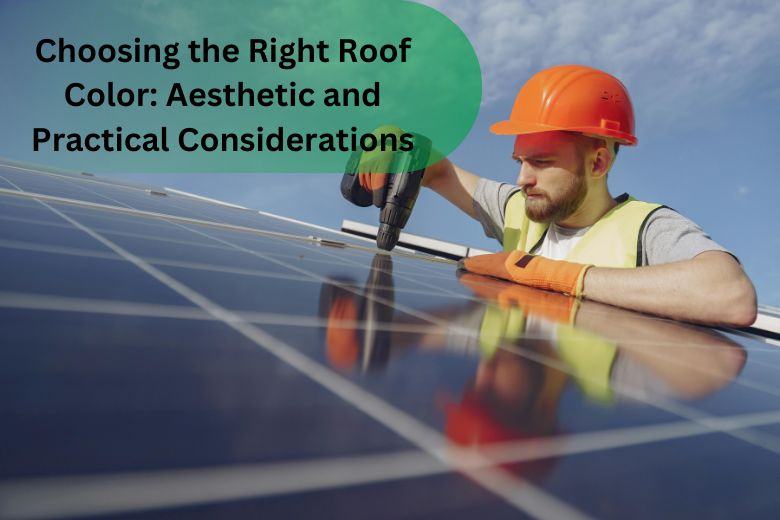Choosing the Right Roof Color: Aesthetic and Practical Considerations
Posted on August 05, 2024 by Admin

Deciding on the right color for your roofing is one of the great decisions in home improvement, as it goes deep into association with aesthetic appeal and functionality for your abode. Your roof color may maximize your house's curb appeal, create a difference in energy efficiency within the house, or sometimes affect resale value in general. See below to consider the following key elements when deciding which color is appropriate for your roof.
Aesthetic Considerations
-
Complementing Your Home's Style
The perfect shade color for the roof should be chosen by the shade that will complement the abode's architecture without ignoring the other exterior color palette. Traditional house color schemes use colors that whisper, not shout. Good choices in pigment for traditional houses are black, gray, or brown; a more modern palette can certainly include blue or green. Consider roof-color blending with such elements as siding, trim, or landscaping.
-
Aesthetics
This should, from the outside view, project some resemblance and attractive appearance of the house. Light colors can make a big size structure appear more massive than what they are, and dark colors add solidity to them. Think of the impact you are aiming the eye to have and settle for a color that will enhance the visual aesthetic of your house.
-
Personal Expression
This is not forgetting the last consideration in how you think of style for your home—your personal taste. A roof is an investment into many years. Most likely, if your taste goes into the conservative color palette, then classic shades of beige or taupe are in store for you. If you want a little flair, then look for something that will add a touch of personality without overdoing the whole design.
Must Read : The Pros and Cons of Flat Roofs vs. Pitched Roofs
Practical Considerations
-
Energy Efficiency
This will bring to light that it is the roof's color that will determine energy efficiency. For example, light-colored roofs are the best since they tend to radiate more sun rays; hence, they will reduce taking in heat. This will end up helping in cooling the house, especially during very sunny and hot weather, hence saving you from some costs that would be incurred from air conditioning. On the other hand, the dark-colored roofs aid in melting snow and ice.
-
Climatic and Weather Conditions
You should consider the general climate and weather around where you are building as you select the appropriate color for your roofing. If you want to keep a building cold in a location that has extremely hot summers, use light-colored roofing, which reverberates a cooling effect around the building. On the other hand, if you want to achieve the exact reverse in cold regions, then opt for dark colors. In contrast to these, dark-colored roofs retain more warmth and can help slash heating costs by quite an appreciable level in cold regions. Also consider whether the color you end up with can pass the rain, snow, and UV rays test.
-
Resale Value
This will offer the maximum number of buyers a very appealing roofing color and help in resale value. These neutral shades establish generally safe choices that most purchasers feel are unobjectionable. Of course, select a color you love, but do not forget to think about how it might affect the marketability of your home in the future.
Faqs
-
1. How Do I Choose a Roof Color to Match My Home's Exterior?
The roof color you choose should blend with your home's exterior based on the siding color and color of the trim, and colors in your landscape. It is advisable to look at color samples to get a feel for how the different shades look at different times of the day.
-
2. Will the color of my roof impact my energy bills?
That is true. Most of the energy input by the sun comes in the form of radiation. Light-colored roofs will reflect a considerable percentage of the sun's radiation compared to dark roofs, thus keeping the building cooler and hence reducing the running costs of air conditioners in hot climates. Dark-colored roofs absorb more heat and, hence, may bring down the heating costs in the cold climates. One must choose carefully according to their respective climate to achieve better energy efficiency.
-
3. Are there maintenance concerns regarding different roof colors?
Various roof colors also come with differences in maintenance issues. Some of the issues include dirt and algae that are quite outstanding in light-colored roofs and thus they will be quite often cleaned. The most common problem associated with dark-colored roofs is that they will have faded over time after coming into contact with ultraviolet rays. Addressing such concerns may involve regular cleaning and making use of quality roofing materials.
Recent Post
- Top Plumbing Service Providers in Arizona, USA
- Top 10 Electrician Service Providers in Alabama, USA
- Top 20 Roof Repair Service Providers in Alabama, USA
- The Role of Roof Insulation in Energy Efficiency: Tips and Tricks
- Understanding Roof Damage from Wildlife and How to Prevent It
- How to Choose the Best Roofing Contractor for Emergency Repairs
- Roofing Maintenance for Historic Homes: Preserving Architectural Integrity
- The Importance of Proper Attic Ventilation for Roof Health
- How to Identify and Prevent Roof Mold and Mildew
- The Best Practices for Removing Snow from Your Roof